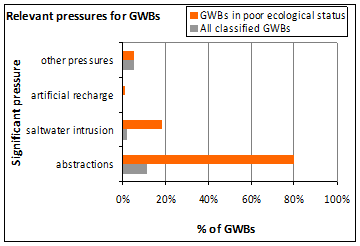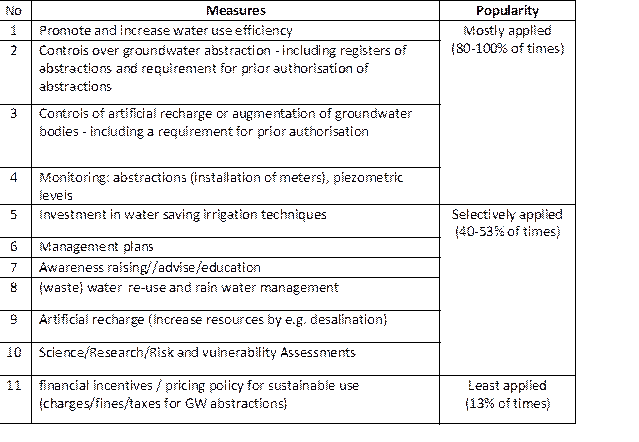Post a comment on the text below
Box 4.4 Groundwater quantitative status
The definition of good groundwater quantitative status according to the WFD requires that the level of groundwater in the groundwater body is such that the available groundwater resource is not exceeded by the long-term annual average rate of abstraction.
From the total number of Groundwater bodies reported in the WFD RBMPs, only 6% (672 Groundwater bodies) are classified as being in poor quantitative status in 2009. Only a few countries, namely Spain, United Kingdom, Belgium, Czech Republic, Germany, Italy, Malta, have groundwater quantitative problems which are though mainly found in specific RBDs and not in the whole country, with the exception of Cyprus where approximately 70% of its Groundwater bodies are in poor status (Map 4.3).
Map 4.3 Percent of Groundwater bodies in poor quantitative status in 2009 per RBD

Data source: WISE-WFD database, February 2012
There are four significant pressures that are affecting groundwater quantitative status based on the WFD. The most commonly reported pressures are water abstraction (in 11% of classified GWBs and 80% of GWBs which are in poor quantitative status), followed by saltwater intrusion (in 18 % of GWBs in poor status). Artificial recharges constitute a pressure in only 1% for GWBs in poor status and finally other pressures are responsible for about 5% of the GWBs in poor quantitative status (Figure 4.9).
Figure 4.9 Relevant pressures for GWBs

Data source: WISE-WFD database, February 2012
The main response measures across Member States (as identified in the WISE-WFD and the compliance check databases) are grouped into 11 categories, varying from voluntary, to regulatory, legislative and financial, as presented in Table 1.
Table 4.1 Groups of measures and popularity

Note: analysis based on 15 RBDs that in 2009 were in poor quantitative status but the projections for 2015 are showing significant improvement
You cannot post comments to this consultation because you are not authenticated. Please log in.



Previous comments
Figure 4.9: In our opinion artificial recharge is more a response to a pressure than a pressure itself.